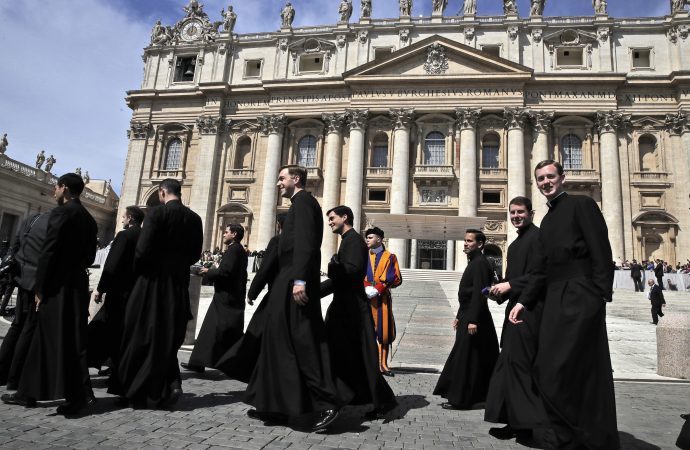On Monday, the scandal-plagued Legionaries of Christ religious order published its latest report detailing what they have done and what they still need to do to repair the damage done and guarantee safe spaces for minors, from third-party investigations to mandatory formation seminars and revealing the names of priests found guilty of abuse.
The religious congregation continues to claim it is cleaning house, after a report released last year showed that the late Father Marcial Maciel Degolaldo, founder of the Legionaries, was far from being the only abusive priest in the movement.
Titled “Truth, Justice and Healing 2020 Annual Report,” the document looks into the implementation of two documents produced at last year’s annual chapter for the order: “Protect and heal” and “Conversion and reparation in relation to the sexual abuse of minors and safe environments.”
According to the Legion, in releasing the report they “first of all bear in mind all the victims who have suffered abuse, known and unknown,” adding that a year ago, they had assured victims and their families of their will to convert and repair the damage with concrete actions. The document also calls on other members of the order to work on healing the wounds of the victims of abuse, while asking the Church in general and society as a whole to “help us to carry out” this determination to prevent abuse and repair the damage of past abuse.
“We keep in our hearts the words that Pope Francis addressed to us at the end of the 2020 General Chapter,” says the report’s introduction. “The path of renewal has not ended, because the change of mentality in individuals and in an institution requires a long time to assimilate, and therefore a continuous conversion.”
Concrete steps in that renewal were established in the two documents released Feb. 26, 2020, and the following report published March 22.
“Protect and Heal,” is a 21-page decree officially establishing clear principles, policies and norms for the protection of minors and vulnerable adults in all institutions run by the Legionaries. These norms include mandatory reporting and procedures for investigation, as well as emphasizing there will be sanctions for those guilty of negligence or the cover-up of abuse.
The measures also include commitments to assisting survivors and “investigating and clarifying cases of abuse from its past in order to reach out to those affected and restore justice,” the document says.
The second document, titled “Conversion and Reparation,” is a 10-page “communique” addressed to all members, pledging the start of a new “mindset” and culture of empathy, conversion, reparation and justice through concrete action and change.
It also addresses all survivors and their families, asking for their forgiveness and officially retracting the negative “judgments” lodged against people “who made legitimate and necessary accusations,” recognizing their voices as being “prophetic” in favor of truth and justice.
The commitments agreed up through both documents, this week’s report says, can be summarized in five points: Attention to victims; reviewing and updating the investigation of past cases; publishing cases of members of the Legion who have been found guilty, taking into account local civil legislation; clarification of possible cases of cover-up or neglect; and a safe environment policy.
Among the steps taken since the end of the General Chapter, the Legionaries of Christ now have an independent and safe channel for victims and survivors of abuse to come forward called Eshma, and has been working with CEPROME, the center for child protection at the Pontifical University of Mexico to provide abuse prevention and safe environments formation.
The document also provides an update on the allegations the Legion has received and investigated. Two-thirds of the Legion’s priestly victims — 60 — were allegedly abused by Maciel, the order’s founder. Most were boys between age 11 and 16.
A report on allegations presented last year, looking into cases from 1941, had collected accusations against 33 Legionary priests. Monday’s report clarified that in two of the cases, “it was not possible to confirm that it was a case of sexual abuse against a minor”: In one of the cases involving a deceased priest, the person who’d made the allegation later clarified that the abuse he suffered hadn’t been sexual; and three of the cases, involving men who are no longer members of the order, are still being investigated.
Of the 27 priests found guilty, or who have confessed their guilt, 16 are still members of the congregation, though not in active ministry.
In 2010, the Vatican took over the Legion and imposed a process of reform, after an investigation showed that Maciel had sexually abused seminarians and fathered at least three children with two women. Maciel was removed from ministry by Pope Benedict XVI in 2006. The German pope had conducted the investigation against the Mexican priest while he was the head of the Congregation for the Doctrine of the Faith, the Vatican office that deals with allegations of clerical abuse against minors.
The Vatican found he had created a system of power built on silence, deceit and obedience that enabled him lead a double life, and which led to a multigenerational chain of abuses: A third of the priestly abusers were themselves victims of Maciel, while others were victims of his victims.

